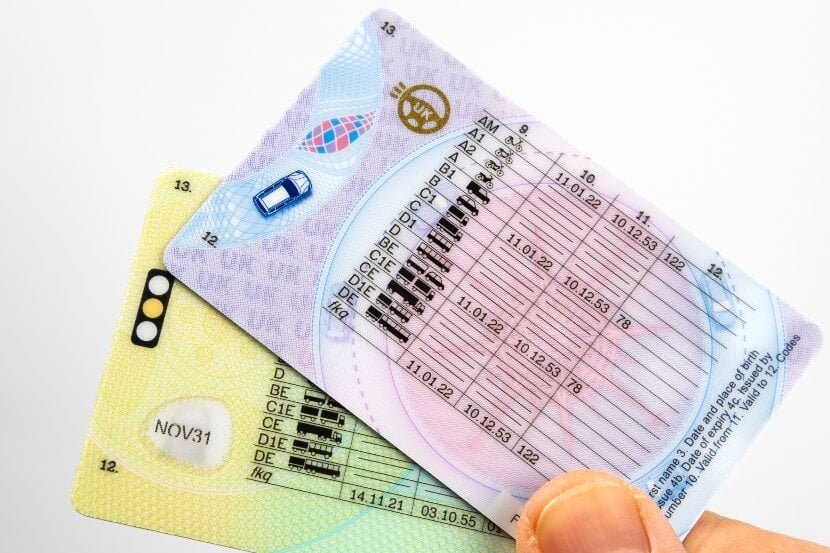ইউনাইটেড কিংডমে ড্রাইভিং লাইসেন্স - একটি ব্যাপক নির্দেশিকা
As the old proverb goes, ‘knowledge is power,’ which is particularly true when navigating the complexities of driving licences in the United Kingdom. Becoming a fully licensed driver involves several key steps, each with its regulations and requirements.
It all begins with obtaining a provisional licence, the gateway to learning how to drive on UK roads. From there, individuals must pass a theory and practical driving test, overseen by the Driver and Vehicle Licensing Agency (DVLA), to get a full UK driving licence.

Navigating the DVLA’s procedures doesn’t end after obtaining your license. A UK driving licence holder must stay informed of the various licences associated with specific vehicle categories and ensure their licence is always up to date.
This may include changing personal details, renewing the licence, or upgrading it to cover new vehicle types. Accessing and managing your driving licence information is facilitated by services provided on gov. uk, which also detail the legal obligations for drivers.
Driving Licence in the United Kingdom – Key Takeaways
- Obtaining and maintaining a UK driving licence involves a structured process guided by the DVLA.
- Drivers must be aware of the different vehicle categories their licence permits them to operate.
- The UK driving licence is an essential document that requires regular updates and checks for accuracy.
Obtaining a Provisional Licence
You must obtain a provisional driving licence before learning to drive a car, motorbike, moped, or other vehicle in the United Kingdom. This section outlines the necessary eligibility criteria and steps to follow in the application process.
যোগ্যতা এবং প্রয়োজনীয়তা
To be eligible for a provisional licence, you must meet the following criteria:
- বয়স: You have to be at least 15 years and 9 months old.
- Residency: You must be a resident of the UK.
- Vision: You must be able to read a vehicle number plate from 20 metres away.
- Identity Documents: Prepare valid identification, such as a UK passport, biometric residence permit, or EU/EEA national identity card.
Specific fees apply for the issuance of a provisional driving licence. You will also require a recent photograph that meets the required standards.
আবেদন প্রক্রিয়া
To apply for your provisional licence, you can either fill in a D1 form from the Post Office or use the online service provided by the DVLA in Swansea. The steps are as follows:
- Collect Documentation: Gather all necessary নথি, including identification and proof that you meet the vision requirement.
- Complete the Form: Fill in the D1 application form or complete the process অনলাইন.
- পেমেন্ট: Pay the requisite ফি for the provisional licence application.
- Submit Application: Post the form with your documents and photograph to the DVLA or submit them online.
It’s essential to ensure all your details are accurate and provide all the required information to avoid delays in receiving your provisional licence.
The UK Driving Test
Obtaining a driving licence in the United Kingdom requires passing a two-part examination: the theory and the practical driving assessment. Each component assesses different skills crucial for safe driving on UK roads.
Theory Test Components
দ্য theory test is your first challenge to gaining a full UK driving licence. It comprises two parts: multiple-choice questions and a hazard perception test. The multiple-choice section covers many topics, all detailed in the Highway Code.
Candidates must answer questions on road signs, driving laws, and other theoretical knowledge needed to drive safely. Following that, the বিপদ উপলব্ধি পরীক্ষা requires you to view a series of video clips and identify developing hazards on the road.
Practical Driving Assessment
You’ll progress to the practical driving assessment once you have successfully passed the theory test. A qualified, approved driving instructor will evaluate your driving skills in this test part. You’ll be tested on various manoeuvres and your ability to drive safely under different road and traffic conditions. To get to this point, you should have spent significant time practising with a professional or a qualified individual as specified by the DVSA.
Booking and Preparation
To schedule your theory or practical tests, you’ll need to visit the official DVSA booking service. Preparing for both parts of your driving test is crucial. For the theory, study the Highway Code, practice hazard perception clips, and take mock tests. For the practical, regular lessons with an approved instructor and additional practice under supervision will help you develop the necessary skills. Passing the UK driving test is not just about getting a driving licence. It’s about becoming a safe and responsible driver.
Types and Categories of UK Driving Licences
When operating a vehicle in the United Kingdom, it’s essential to hold the correct type of চালনার অনুমতিপত্র for the vehicle you intend to drive. Your driving licence determines the vehicle category you’re authorised to drive and any restrictions or conditions that may apply.
Understanding Licence Categories
Every driver in the UK needs to ensure they are driving within the limitations of their licence category. Category B is The most common category, allowing you to drive vehicles up to 3,500kg maximum authorised mass (MAM) with up to 8 passenger seats and tow certain trailers.
Categories ক এবং A1 cover motorcycles, with or without a sidecar, while Category C includes larger vehicles such as lorries. For those riding mopeds, Category AM applies. A full breakdown and guidance on these can be found on the GOV—UK driving licence categories পৃষ্ঠা
- Category A, A1: Motorcycles
- Category B: Cars, vehicles up to 3,500kg MAM
- Category C: Large goods vehicles
- Category AM: Mopeds and light quad bikes
Additional categories and subcategories allow vehicles to be driven, including buses, coaches, and tractors. Each category has its own set of restrictions and requirements; for example, age restrictions vary, and some require you to pass additional tests. Be sure to check your licence number for details on your entitlements, as the codes next to each category list specific restrictions or conditions under which you’re allowed to drive.
Endorsements and Penalty Points
If a driving offence is committed, the UK driving licence might be endorsed with penalty points designed to encourage safe driving. Endorsements are recorded on your driving licence and can affect insurance premiums and possibly result in disqualification.
- Points typically stay on your licence for 4 or 11 years
- Accumulating 12 points in 3 years can lead to disqualification
The penalty points system serves as a reminder of the consequences of unsafe driving and the importance of adhering to driving laws. Information on what specific codes entailing endorsements mean can be found through resources such as the RAC’s explanation of driving licence codes and categories. Understanding the types of vehicles you are permitted to drive and the potential penalties for driving offences is crucial for maintaining a valid driving licence in the UK.
Maintaining and Updating Your Licence
Keeping your driving licence up-to-date is essential for staying on the right side of the law and ensuring that your driving record accurately reflects your current situation. Whether you need to renew your photocard, update personal details, or replace a lost or stolen licence, the Driver and Vehicle Licensing Agency (DVLA) has straightforward processes.
Renewal and Photocard Updating
You must renew your photocard driving licence every ten years to ensure your photo resembles your current appearance. You can use the online government service, which carries a fee of £14, or renew at a post office for a slightly higher cost.
If you choose to renew at the post office, you’ll need your reminder letter or your current photocard licence, which costs £21.50. Be aware that it’ll take up to three weeks to receive your new driving licence when you apply.
Changing Personal Details
It’s essential to keep your details up to date, including your name, address, or স্বাক্ষর. Updating your address is free of charge and can be done through the government’s website. For changes in name or signature, you may need to send supporting documents by post, and the fee varies depending on the nature of the update.
Ensure your driving record is current to avoid potential fines; you must inform the DVLA when your details change.
What to Do If Your Licence Is Lost or Stolen?
If you find yourself without a driving licence because it’s either been lost বা stolen, report it to the police and get in touch with DVLA customer services immediately. There’s a £20 ফি প্রতি replace a lost or stolen licence. The replacement process can be initiated অনলাইন or at a Post Office that handles DVLA photocard licence renewal.
Promptly reporting a stolen driving licence to the police and the DVLA helps protect your identity and prevents potential misuse of your licence.






